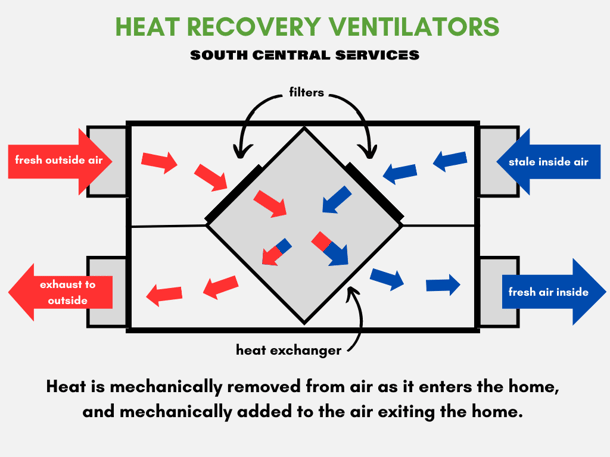Checking out the Perks of Heat Recovery Ventilation for Power Efficiency in Homes
Heat Recovery Ventilation (HRV) systems provide house owners a sensible strategy to enhancing energy efficiency. By recovering heat from outgoing air, these systems can significantly reduce cooling and heating costs. In addition, they supply a constant supply of fresh air, boosting interior air high quality and comfort degrees. As house owners think about sustainable alternatives, comprehending the nuances of HRV systems comes to be progressively vital. What elements should one evaluate prior to making such an investment?
Recognizing Heat Recovery Ventilation Solutions

Just How HRV Enhances Indoor Air Top Quality

Power Cost Savings: The Monetary Benefits of HRV
Optimizing energy efficiency, heat recovery ventilation (HRV) systems offer considerable monetary benefits for property owners. By recuperating and reusing heat from exhaust air, HRVs noticeably lower cooling and heating prices. This innovation can lead to power savings of up to 30%, relying on climate and use patterns. House owners typically notice minimized this website energy bills shortly after installment, making HRVs a monetarily smart financial investment gradually. Additionally, numerous regions offer motivations or refunds for energy-efficient upgrades, additionally enhancing the economic appeal. As energy rates proceed to climb, the cost-effectiveness of HRVs comes to be significantly clear. Overall, the consolidation of HRV systems not only promotes energy performance but also adds to long-lasting economic cost savings for families.
The Ecological Effect of Heat Recovery Ventilation
A significant environmental advantage of heat recovery ventilation (HRV) systems depends on their capability to reduce overall energy usage. By recovering warmth from exhaust air and transferring it to incoming fresh air, HRV systems reduce the need for energy-intensive home heating and cooling down methods. This reduction in power need adds to decrease greenhouse gas discharges, as less fossil fuel is needed to preserve comfy interior temperatures. Furthermore, HRV systems improve interior air top quality by efficiently exchanging stale air with fresh outside air, minimizing dependence on mechanical cooling systems that can damage the setting. On the whole, the execution of HRV systems supports sustainable living practices and lines up with international initiatives to deal with climate adjustment by promoting power performance in property settings.
Choosing the Right HRV System for Your Home
Just how can house owners assure they select the appropriate heat recovery ventilation (HRV) system for their demands? Initially, they ought to assess their home's size and layout, as these variables influence airflow requirements. Next, reviewing the system's effectiveness rankings is important, as higher rankings suggest much better efficiency and energy financial savings. Property owners need to also take into consideration installation and upkeep costs, contrasting various brands and designs for value. Furthermore, it's essential to assess noise degrees, as some systems run more silently than others. Consulting with heating and cooling experts can supply tailored suggestions based upon particular home conditions. Finally, checking out user evaluations and service warranties can aid in making an informed decision, making certain that the selected HRV system efficiently improves indoor air high quality and power effectiveness.
Often Asked Questions

Exactly how Often Should I Clean or Keep My HRV System?
The regularity of cleaning or keeping a warmth recuperation go now air flow get redirected here (HRV) system usually depends upon use and ecological variables. Normally, it is a good idea to execute upkeep every six months to ensure peak efficiency and air high quality.

Can HRV Equipments Help In Reducing Moisture Degrees Indoors?
HRV systems can successfully reduce indoor humidity levels by exchanging stagnant, humid air with fresh, drier air from outdoors. HRV Heat Recovery Ventilation. This procedure aids keep a well balanced interior environment, improving convenience and avoiding moisture-related issues
What Is the Life expectancy of a Regular HRV System?
The life-span of a typical heat recovery ventilation (HRV) system varies, normally lasting between 10 to 15 years. Routine upkeep can prolong its efficiency and functional life, making certain peak performance throughout its usage duration.
Are There Any Sound Concerns With HRV Systems?
Sound interest in HRV systems can arise, specifically from follower procedure. However, many modern-day systems are created to minimize audio degrees, ensuring they run quietly while maintaining performance, which resolves potential disruptions in living environments.
Can I Install an HRV System Myself, or Do I Required a Professional?
The private contemplated whether to install the heat recovery ventilation (HRV) system directly or hire an expert. Generally, while do it yourself setup is feasible, competence assurances appropriate functionality and compliance with local building ordinance, improving system effectiveness.